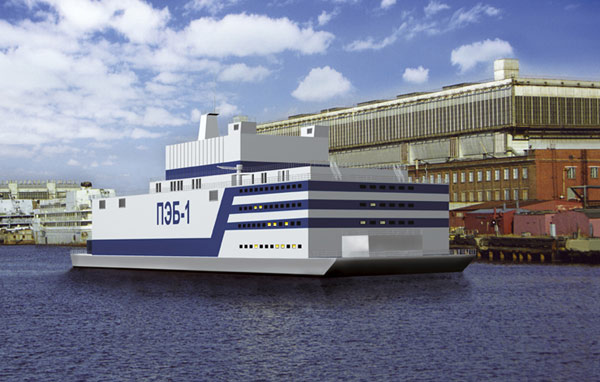
Floating Nuke Plants to Contain Earthquake, Tsunami Threats
As the nuclear industry is still reeling from the tsunami-caused meltdown at Fukushima Daichii nuclear power plant in Japan in 1911, with nuclear programs slashed and many of the existing plants marked for shutdown across the world, contractors appear in for a reprieve with floating nuke plants under construction or on drawing boards.
A team of researchers from the Massachusetts Institute of Technology (MIT) has come up with a design for nuclear plants built on floating platforms, like offshore oil rigs, presented at the Small Modular Reactors Symposium, hosted by the American Society of Mechanical Engineers.
A similar plant, first of a planned series to supply power to Russian North Sea ports, is nearing completion at a St. Petersburg shipyard.
Unlike the American design, however, the Russian plant is constructed on a barge. Incorporating two navy-type reactors like those powering submarines and Arctic icebreakers, the plant is to supply 70 MW of electricity or 300 MW of heat, sufficient for a town of 200.000 people.
1. Living area. 2. Nuclear power plant operating room. 3. Reactors. 4. Steam turbine installation. 5. Power generation area. 6. Storage area for spent fuel.
It can also be used for seawater desalination to provide 240.000 cubic meters of fresh water a day. Russian contractors have reportedly claimed the reactor would not be damaged by the impact of a jetliner in case of an accident.
The MIT designers, led by professor Jacopo Buongiorno, envisage a rig-like plant, to be built at a shipyard and then to be towed and moored to the ocean bottom eight to ten kilometers from the shore, to be connected to the grid via an underwater electric transmission line.
The distance from the shore and the 100-meter depth of the seafloor, would make the plant impervious to tsunami waves and ground shaking. The MIT scientists point out that Fukushima disaster was caused not by the Tohoku quake and the devastating tsunami it produced, but by the loss of electric power which prevented reactor-cooling mechanism to kick in and prevent the melt down of fuel rods, as were the case in Chernobyl and Three Mile Island accidents. Therefore their model was pivoted on preventing meltdown. The beauty of the concept, according to the designers, is that it incorporates passive safety mechanisms, leaving the task of cooling the core, located below the surface to the ocean waters. The design also features safety measures against underwater attack. When it is time for decommissioning the plant, it will simply be towed away to a central facility, the way it is done for the reactors powering the U.S. aircraft carriers and the fleet of nuclear submarines.
The MIT designers foresee a promising market in Asia, where tsunami risk is high and developing economies and rapid urbanization create a nearly insatiable hunger for energy. The modular concept is suitable for varying need, since plants could be built for just 50 MW of power, or a series of reactors could generate up to 1000 MW of electricity.
REFERENCES
- 1. “Floating nuclear plants could ride out tsunamis”, Massachusetts Institute of Technology, 16 April 2014
- 2. “Russian floating nuclear power station”, http://en.wikipedia.org/wiki/Russian_floating_nuclear_power_station
- 3. http://www.marinebuzz.com/2008/05/22/how-safe-are-the-floating-nuclear-power-plants-of-russia/



